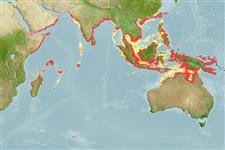Teleostei >
Clupeiformes (Herrings) >
Dorosomatidae (Gizzard shads and sardinellas)
Etymology: Hilsa: Bangladesh and Bengali local name for a fish.
More on author: Cuvier.
Environment: milieu / climate zone / depth range / distribution range
生態學
海洋; 淡水; 半鹹淡水; 溯河洄游 (Ref. 51243); 深度上下限 10 - ? m (Ref. 30573). 熱帶; 25°N - 18°S, 43°E - 155°E (Ref. 54554)
Indo-West Pacific: probably all coasts of Indian Ocean, from Gulf of Oman and Gulf of Aden south to Durban and Madagascar, across the Bay of Bengal, Gulf of Thailand, Java Sea and north to Hong Kong and east to Papua New Guinea and possibly further (Ref. 188).
印度-西太平洋: 印度洋的可能所有海岸,從阿曼灣與亞丁灣南至南非的川斯凱與馬達加斯加, 越過孟加拉灣,泰國灣, 爪哇海而且北至香港而且東至巴布亞新幾內亞與可能更遠。
Length at first maturity / 大小 / 重量 / 年齡
Maturity: Lm 15.0 range ? - ? cm
Max length : 35.0 cm TL 雄魚/尚未辨別雌雄; (Ref. 11228); common length : 16.5 cm SL 雄魚/尚未辨別雌雄; (Ref. 188)
背棘 (總數) : 0; 背的軟條 (總數) : 16 - 19; 臀棘: 0; 臀鰭軟條: 17 - 23. Diagnosis: Body fairly deep and compressed, belly with distinct keel of scutes; top of head with numerous fronto-parietal striae; upper jaw with median notch; gillrakers about 100 to 175, those on inner arches distinctly curled; outer row of gill filaments on first arch not more than half length of gillrakers; a series of small triangular scales above axil of pectoral fin; hind part of body scales perforated (Ref. 188). A black spot behind gill cover, usually followed by up to 10 spots along flank (Ref. 188).
頭頂有很多的額頂骨陷紋; 上頜有中央的凹槽。 鰓耙大約 100 到 175, 在內弓上的那些明顯地捲曲; 在第一鰓弓上的鰓絲的外部列不超過鰓耙的一半長度。 在胸鰭的葉腋上面的一系列的小三角形的鱗片; 身體鱗片的後部部份穿孔的。 在鰓裂後面的一個黑色的斑點; 通常 10 沿著側面。
Found in coastal waters (Ref. 3107, 30573); marine, pelagic, but entering estuaries and able to tolerate quite low salinities (7 ppt) (Ref. 188). Feeds chiefly on phytoplankton, mainly diatoms, also dinoflagellates, but also copepods, molluscan and crustacean larvae, prawns, amphipods and polychaetes (Ref. 188). Spawns, at least in Godavari estuary, around February (Ref. 188). Marketed fresh, dried, dried-salted and boiled. Made into fish balls.
發現於沿岸水域 (參考文獻 30573), 進入河口而且能容忍相當低的鹽度 (7個 ppt) 。 主要捕食浮游植物 (主要地矽藻 , 也吃腰鞭毛蟲) ,也吃橈足類, molluscan 與甲殼類幼生,蝦,片腳類動物與多毛類動物。 產卵 (至少在 Godavari 河口) 二月左右。 (參考文獻 188) 在市場上銷售生鮮地,乾製了, 乾燥鹽醃與煮沸的。 製成了魚丸。 發現於下面湄公河的整個流域主流了。 (參考文獻 36667)
Life cycle and mating behavior
成熟度 | 繁殖 | 產卵場 | 卵 | 孕卵數 | 仔魚
印度-西太平洋: 印度洋的可能所有海岸,從阿曼灣與亞丁灣南至南非的川斯凱與馬達加斯加, 越過孟加拉灣,泰國灣, 爪哇海而且北至香港而且東至巴布亞新幾內亞與可能更遠。
Whitehead, P.J.P., 1985. FAO Species Catalogue. Vol. 7. Clupeoid fishes of the world (suborder Clupeoidei). An annotated and illustrated catalogue of the herrings, sardines, pilchards, sprats, shads, anchovies and wolf-herrings. FAO Fish. Synop. 125(7/1):1-303. Rome: FAO. (Ref. 188)
IUCN 瀕危狀態 (Ref. 130435: Version 2024-2)
無危 (LC) ; Date assessed: 11 July 2018
人類使用
漁業: 高經濟性; 誘餌: occasionally
工具
特別的報告
下載 XML
網路資源
Estimates based on models
Preferred temperature (Ref.
123201): 25.8 - 29.1, mean 28.3 °C (based on 772 cells).
Phylogenetic diversity index (Ref.
82804): PD
50 = 1.0000 [Uniqueness, from 0.5 = low to 2.0 = high].
Bayesian length-weight: a=0.01023 (0.00643 - 0.01629), b=3.03 (2.90 - 3.16), in cm total length, based on LWR estimates for this species & (Sub)family-body (Ref.
93245).
營養階層 (Ref.
69278): 2.9 ±0.33 se; based on food items.
Generation time: 1.0 ( na - na) years. Estimated as median ln(3)/K based on 1
growth studies.
回復力 (Ref.
120179): 高度, 族群倍增時間少於 15個月 (K=1.1).
Fishing Vulnerability (Ref.
59153): Low vulnerability (18 of 100).
Climate Vulnerability (Ref.
125649): High to very high vulnerability (71 of 100).
Nutrients (Ref.
124155): Calcium = 204 [116, 375] mg/100g; Iron = 2.01 [1.12, 3.29] mg/100g; Protein = 19.2 [18.1, 20.2] %; Omega3 = 0.411 [0.231, 0.728] g/100g; Selenium = 61.5 [30.1, 125.8] μg/100g; VitaminA = 9.95 [4.03, 23.19] μg/100g; Zinc = 1.78 [1.25, 2.60] mg/100g (wet weight);
